What Is QAM?
Quadrature amplitude modulation (QAM) is an advanced modulation scheme widely used in Wi-Fi communication systems. It combines phase modulation and amplitude modulation.
Why Do We Need QAM?
When used for Wi-Fi digital signal modulation, QAM can achieve a higher rate than common amplitude modulation and phase modulation, which support only two types of symbols to distinguish 0 and 1.
- Amplitude modulation: distinguishes 0 and 1 by changing the carrier amplitude.
- Phase modulation: distinguishes 0 and 1 by changing the carrier phase. For example, binary phase shift keying (BPSK) uses phases 0° and 180° for transmitting a single bit (0 or 1) of information. In contrast, QPSK can encode 2 bits per symbol (00, 01, 10, or 11) through the following four phases: 0°, 90°, 180°, and 270°. In fact, QPSK is a special type of QAM, that is, 4-QAM.
QAM can modulate more symbols, and each symbol has its own phase and amplitude.
For example, 16-QAM can modulate symbols into 16 different waveforms, representing 0000, 0001, and so on, as shown in the following figure. This means that a total of 16 types of symbols are available, each of which may transmit 4-bit information.
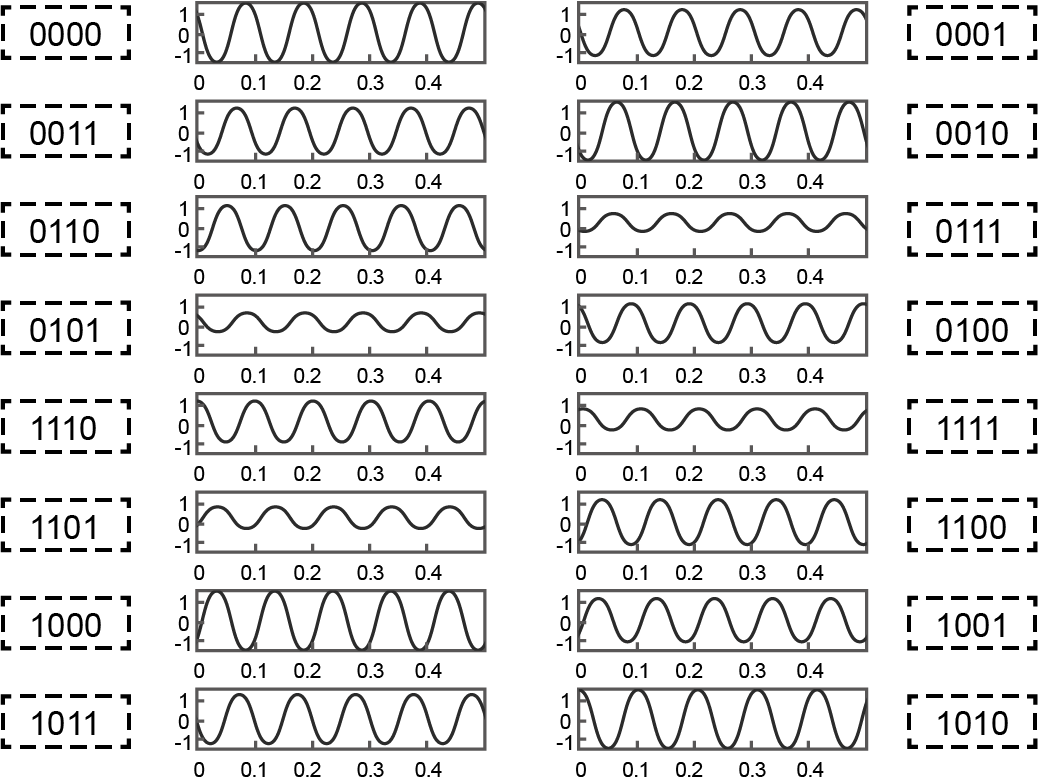
16-QAM diagram
How Does QAM Work?
QAM loads signals to two orthogonal carriers (typically sine and cosine), adjusts the amplitudes of the carriers, and superimposes their amplitudes to generate the signals modulated by both the phase and amplitude. The two carriers are usually referred to as I and Q signals. Therefore, this modulation mode is also known as IQ modulation.
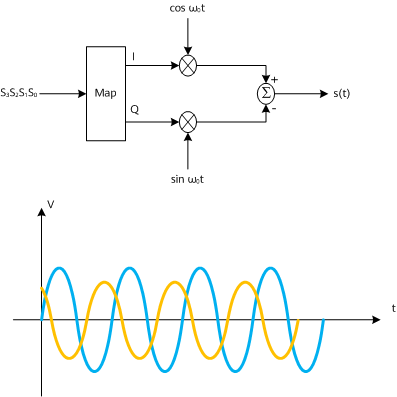
IQ modulation
QAM is also considered a combination of phase modulation and amplitude modulation because QAM-modulated signals involve the conversion of both the phase and amplitude.
QAM Constellation Diagram
In digital signal modulation, a constellation diagram is typically used to represent a two-dimensional QAM modulation graph. Compared with IQ modulation, the constellation diagram maps data modulation information (including amplitude and phase information about signals) to polar coordinates.
Each constellation point represents a symbol. Components of a point on the I and Q axises represent the amplitude adjustment of orthogonal carriers. The distance A from the point to the origin (0,0) represents the amplitude after modulation, and the angle φ of the point represents the phase after modulation.
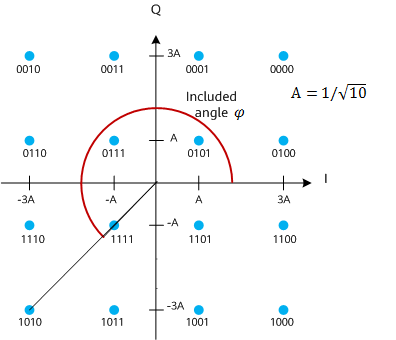
QAM constellation diagram
On a constellation diagram, points are symmetrically distributed in a square grid. The number of constellation points in the grid determines the number of bits carried in each symbol. The following lists two typical QAM examples:
- 256-QAM: 256 is the 8th power of 2, so each symbol can carry 8-bit data.
- 1024-QAM: 1024 is the 10th power of 2, so each symbol can carry 10-bit data.
Therefore, higher-order 1024-QAM achieves a 25% higher peak rate for data transmission than 256-QAM.
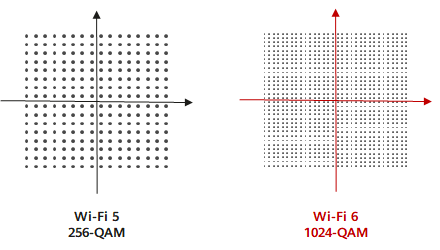
1024-QAM supported in Wi-Fi 6
Impact of Noise and Interference on QAM
A higher-order modulation rate can provide a higher data transmission rate and higher spectral efficiency for a radio communication system. However, higher-order modulation schemes have much poorer adaptability to noise and interference.
As the carrier bandwidth used for transmitting a symbol and the transmission duration are both fixed, a higher order leads to a smaller difference between two symbols. This poses high requirements on the environment and components of the receiver and transmitter. This means that a lower-order QAM scheme is the only option in these harsh, noisy environments.
How Does QAM Work with Wi-Fi?
QAM Modes Adopted by Wi-Fi Standards
For higher data transmission rates, Wi-Fi standards adopt higher and higher QAM orders.

QAM modes adopted by different Wi-Fi standards
How QAM Affects Wi-Fi Data Transmission Rates
Wi-Fi standards define modulation and coding schemes (MCSs), each of which represents a group of modulation and coding modes. For example, in Wi-Fi 6, 12 MCS indexes are available.
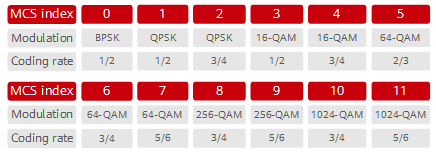
Modulation modes and coding rates corresponding to MCS indexes in Wi-Fi 6
In MCS 1, the QPSK modulation mode is used; in MCS 11, the 1024-QAM modulation mode is used.
For a given MCS index, the transmission rate can vary with the channel bandwidth, number of spatial streams, and guard interval (GI).
The following figure shows the rate calculation formula.

Rate calculation formula in Wi-Fi standards
All of this proves that the data rate can be significantly increased by using a higher-order modulation mode.
- Author: Zhou Xia
- Updated on: 2022-04-02
- Views: 49501
- Average rating:







